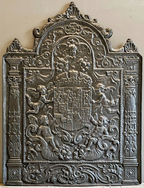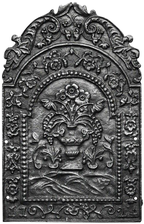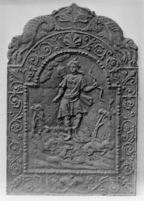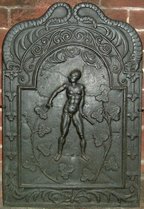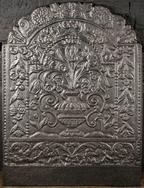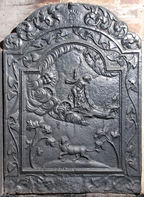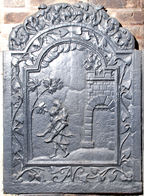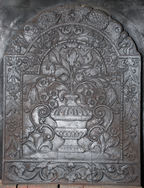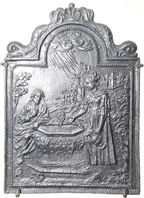-
1203
Description: Arched rectangular central panel with bead on fillet edging; central shield of the Dutch house of Orange impaling English royal Stuart, surmounted by a crown and supported by two putti; above, a maske with two descending grape bunches; below, two more putti seated on scrolls and cornucopiae; a drapery swag and bow in each top corner; arched rectangular border with cavetto-moulded edging and canted top corners; on each side, a Corinthian column and entablature on a pedestal, the columns with floriate decoration; below, a symmetrical swirled design; above the arch, from a scallop shell on each shoulder, two serpents rising towards a third scallop on top.
Notes: The arms are of William IV Prince of Orange (1650-1702) impaling those of his wife, Mary, Queen of Great Britain. Note, these are not the royal arms of William III and Mary II as joint sovereigns, but as Prince and Princess of Orange. William and Mary married in 1677 and Mary died in 1694, so the fireback dates from between 1689, when Mary became Queen, and 1694. A fireback of the same design with the arms of Louis XIV of France is illustrated by Elling and Winkler-Borck, p.213; it has the initials AD in the cartouche above the arch, not visible on this casting.
Arms: William of Orange
Manufactured: in the late-17th century possibly in the Siegerland area of Germany.
Current location: Lassco, Three Pigeons, Milton Common, , Great Milton, Oxfordshire, England.
Citation: Elling, W. & Winkler-Borck, S., 1992, Ofen- und Kaminplatten (Vreden, Hamaland-Museum).
-
53
Description: Arched rectangular shaped central panel, bead on fillet edging, narrow-necked urn with flowers issuing therefrom; arched rectangular shaped border with fillet edging and symmetrical floral swags; on top, stylised fish with floral accessories; at bottom, two looped 'W' figures between split date in bottom corners. A faint plankline, slightly inclined from the vertical and more evident on a later casting, can be seen slightly left of centre.
Notes: The second smallest of six flower vase designs in this series. All incorporate the looped 'W' motif which may be intended to identify the pattern maker. A clear vertical plankline left of centre.
Copies of this fireback are known.
Inscription: 17 24
- Decoration tags:
- 'Dutch' (shape)
- fillet (edging)
- whole carved pattern
- planklines
- pictorial
- text
- plants
- objects
Manufactured: in 1724 in England.
Current location: Thornhill Galleries, 43-45 Wellington Crescent, New Malden, Surrey, England.
- Attached to series:
- 1724 series
- British 'Dutch' style firebacks
-
867
Description: Arched rectangular central panel; bead-and-pellet edging; pictorial scene of a male figure, standing on a ground with trees and animals, with a quiver of arrows and holding a bow in his left hand; clouds above; arched rectangular border with fillet edging; repeated, linked scroll-work on all sides; on top symmetrical leaves between two mirrored serpents.
Notes: The figure is probably that of Apollo.
- Decoration tags:
- 'Dutch' (shape)
- fillet (edging)
- whole carved pattern
- mythological
- animals
- humans
- plants
Manufactured: in the early-18th century in England.
Current location: Metropolitan Museum of Art, 1000, Fifth Avenue, New York, New York, United States of America.
Museum number: 08.81.2 (part of the Metropolitan Museum of Art, New York museum group)
- Attached to series:
- British 'Dutch' style firebacks
-
500
Description: Arched rectangular shaped central panel with astragal and fillet edge, pictorial, a bald, naked man, standing on a mound, holding a baton in his left hand, surrounded by leaf fronds to left and right, and clouds above; arched rectangular shaped border, fillet edging, hanging leaf clusters to left and right, swirled lines above, and draped foliage with monogram at base; on top are two serpents and draped foliage.
Notes: The figure may represent Pheidippides, the messenger between Athens and Sparta during the Battle of Marathon in 490BC.
Copies of this fireback are known.
Inscription: TAN
- Decoration tags:
- 'Dutch' (shape)
- fillet (edging)
- whole carved pattern
- pictorial
- mythological
- monogram
- text
- humans
Manufactured: in the early-18th century probably at Ashburnham Furnace in the Weald area of England.
Current location: West Berkshire Museum, Newbury, Berkshire, England.
Citation: Lloyd, N., 1925, 'Domestic Ironwork I', Architectural Review, 58, pp. 58-67.
- Attached to series:
- TAN series
- British 'Dutch' style firebacks
-
710
Description: Arched rectangular central panel with bead edging; figure of a man with a shield, brandishing a sword in his right hand, a lion behind him; arched rectangular border with astragal and fillet edging; mirrored swirled foliate design; on top, a scallop shell between two descending sea serpents.
Notes: The figure is probably Hercules who was charged by Eurystheus to slay the Nemean lion, one of his 12 labours.
Copies of this fireback are known.
- Decoration tags:
- 'Dutch' (shape)
- astragal & fillet (edging)
- whole carved pattern
- pictorial
- mythological
- animals
- humans
Manufactured: in the mid- to late-17th century in the Siegerland area of Germany.
Current location: Great Dixter, Northiam, East Sussex, England.
- Attached to series:
- 'Dutch' Miscellaneous Firebacks
-
1161
Description: Arched rectangular central panel with bead-and-pellet edging (top and sides); on a ground between two plants, their flowers upstanding, a gadrooned flower vase with two, scrolled handles, tulips and other flowers issuing from the narrow neck; arched rectangular border with fillet edging; mirrored descending flower swags; along a rectangular bottom panel with fillet edging a symmetrical arrangement of swirled foliage; on top, two mirrored sea serpents; at the sides, a narrow vertical extension bordered with a fillet and with bead infill; at the base, a plain extension panel.
Notes: The presence of tulips suggest a Dutch origin for the pattern of this fireback, although the presence of several examples in England suggest that it was produced there rather than on the Continent. One of several very similar designs, varied by the forms of the vases, the style of the flowers and by their dimensions.
Copies of this fireback are known.
- Decoration tags:
- 'Dutch' (shape)
- fillet (edging)
- whole carved pattern
- extension panels
- pictorial
- plants
- objects
Manufactured: in the late-17th century in England.
Current location: not known.
- Attached to series:
- Flower Vase 'Dutch' types
- British 'Dutch' style firebacks
-
509
Description: Arched rectangular central panel with astragal and fillet edging; Phaëton riding Apollo’s chariot across the skies, the sun to the left behind clouds, a lion on ground below, between two trees; arched rectangular border with fillet edging; trailing convolvulus leaves surround the central panel; on top, earl’s coronet above an illegible character, between mirrored, swirled foliage.
Notes: The illustration upon which the design has been based has not been identified, save that it figures in book II of Ovid's Metamorphoses. The convolvulus border is a common feature of this series of firebacks and can be compared with other. The wooden pattern from which this casting was made survives in the collection of the Sussex Archaeological Society (no. 928).
- Decoration tags:
- 'Dutch' (shape)
- fillet (edging)
- whole carved pattern
- planklines
- pictorial
- mythological
- animals
- humans
- objects
Manufactured: in the early-18th century at Ashburnham Furnace in the Weald area of England.
Current location: Penhurst Manor, Penhurst, East Sussex, England.
- Attached to series:
- TAN series
- British 'Dutch' style firebacks
-
510
Description: Arched rectangular central panel with astragal and fillet edging; to the left, Æneäs carrying his father, Anchises; to the right, an arched gateway and portcullis beneath battlements with flames rising therefrom; above left, clouds; far left, a tree; arched rectangular border with fillet edging; trailing convolvulus leaves surround the central panel; plain rectangular extensions to the bottom and each side; on top, mirrored, swirled foliage.
Notes: Many of the early illustrated editions of Ovid’s Metamorphoses show Æneäs escaping from burning Troy, with his father on his back, most of them with an archway in the background.
Copies of this fireback are known.
Inscription: TAN
- Decoration tags:
- 'Dutch' (shape)
- fillet (edging)
- whole carved pattern
- planklines
- extension panels
- pictorial
- mythological
- architectural
- monogram
- text
- humans
Manufactured: in the early-18th century at Ashburnham Furnace in the Weald area of England.
Current location: Penhurst Manor, Penhurst, East Sussex, England.
- Attached to series:
- TAN series
- British 'Dutch' style firebacks
-
516
Description: Arched rectangular central panel with bead-and-pellet edging; on a ground between two plants, a gadrooned flower vase with two, scrolled handles, tulips and other flowers issuing from the narrow neck; arched rectangular border with fillet edging; mirrored descending flower swags; along a rectangular bottom panel with fillet edging a symmetrical arrangement of swirled foliage; on top, two mirrored sea serpents.
Notes: The presence of tulips suggest a Dutch origin for the pattern of this fireback, although the presence of several examples in England suggest that it was produced here rather than on the Continent.
Copies of this fireback are known.
- Decoration tags:
- 'Dutch' (shape)
- fillet (edging)
- whole carved pattern
- planklines
- pictorial
- plants
- objects
Manufactured: in the late-17th century in England.
Current location: Penshurst Place, Penshurst, Kent, England.
- Attached to series:
- Flower Vase 'Dutch' types
- British 'Dutch' style firebacks
-
545
Description: Arched rectangular central panel with canted top corners and bead-on-fillet edging; pictorial scene of Jesus at the well with the woman of Samaria; arched rectangular border with fillet edging; on top, central scallop shell with a descending dolphin on each side of the arch.
Notes: A scene from the New Testament - John 4. Mitford Collection, Petworth House.
Copies of this fireback are known.
Manufactured: in the mid- to late-17th century in the Siegerland area of Germany.
Current location: Petworth House, Petworth, West Sussex, England.
Museum number: NT/PET/M/100 (part of the National Trust museum group)
- Attached to series:
- 'Dutch' Miscellaneous Firebacks
- New Testament firebacks
